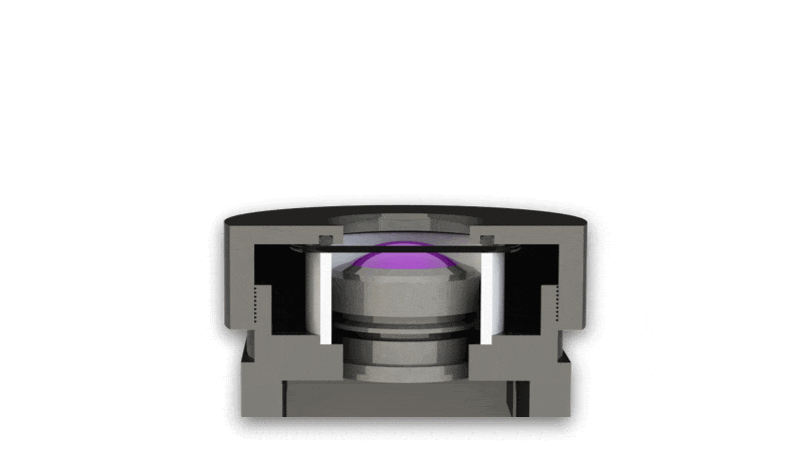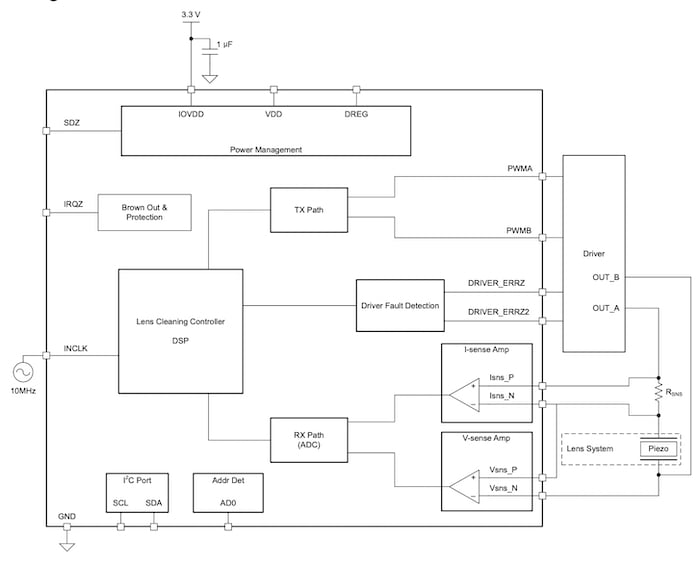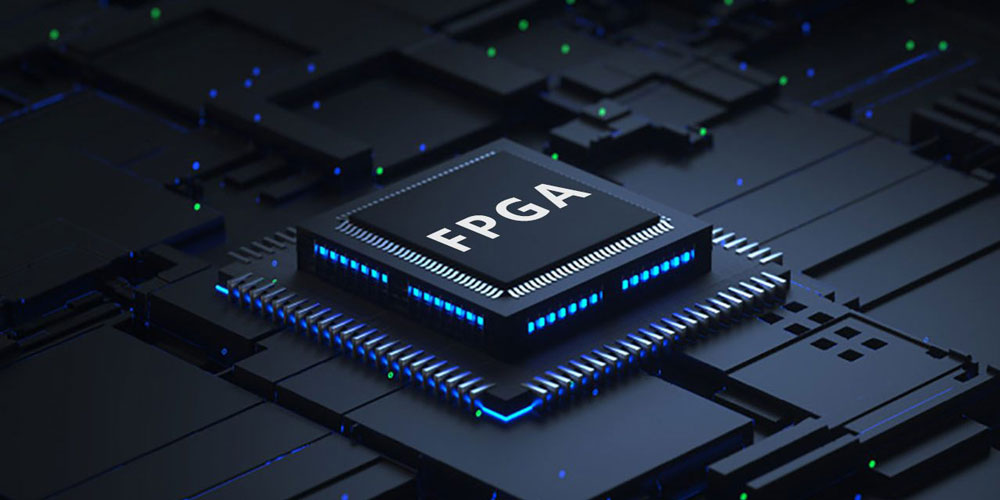TI(Texas Instruments)Advanced Ultrasonic Lens Cleaning Chipset Enables Self-Cleaning Cameras and Sensors
Introduction
Computer vision and advanced imaging have enabled many revolutionary technologies, one of the most important being Advanced Driver Assistance Systems (ADAS) and autonomous vehicles.
Whether the vehicle's imaging comes from cameras, radar, or LiDAR, one constant is that the sensor needs an unobstructed view to do its job. For this reason, the automotive industry is constantly looking for ways to prevent and remove debris and contaminant buildup from vehicle image sensors.
Catalog
ⅠWhat is the advantage of Ultrasonic Lens Cleaning Chipset?
Ⅱ Principle of ultrasonic lens cleaning
Ⅲ TI First Lens Cleaning Chip
Ⅳ Reduce system size and complexity with integrated solutions
Ⅴ Packaging, Availability and Pricing
ⅠWhat is the advantage of Ultrasonic Lens Cleaning Chipset?
Texas Instruments Introduces Advanced Application-Specific Semiconductors with Ultrasonic Lens Cleaning (ULC) Technology That Enable Camera Systems to Quickly Detect and Remove Dirt, Ice, and Water Using micro-vibrations
Traditionally, removing contamination from camera lenses required manual cleaning, which caused system downtime, or various mechanical components that could fail. TI's new ULC chipset, which includes the ULC1001 digital signal processor (DSP) and companion DRV2901 piezoelectric transducer driver, uses a proprietary technology that allows the camera to quickly self-clean contaminants using precisely controlled vibrations for fast Eliminates debris, improving system accuracy and reducing maintenance requirements. The chipset offers designers a compact and affordable way to use ULCs in a variety of applications and different camera sizes.
"ULCs could make widespread use of self-cleaning cameras and sensors a reality," said Avi Yashar, product marketing engineer at TI. "Existing cleaning methods are costly and impractical, requiring complex mechanics, expensive electronics, and extensive handling. to detect contaminants and perform cleaning. As the number of cameras proliferates in applications ranging from automotive and traffic cameras to smart cities and manufacturing, there is a pressing need for an easy and cost-effective way to implement self-cleaning cameras .”
The ULC1001 controller includes proprietary algorithms for automatic sensing, cleaning, temperature, and fault detection without any image processing, making ULC technology highly adaptable for use in a variety of camera lens designs. The chipset's small form factor makes it possible to improve machine vision and sensing in a variety of applications, anywhere a camera or sensor might get dirty.
"As advanced driver assistance systems (ADAS) become more complex and drivers rely more on them, it is more significant than ever to keep sensor suites up and running at all times," said Edward Sanchez, Senior Analyst, Global Automotive, TechInsights. Dirt or foreign objects on the camera lens is a nuisance for rearview cameras but becomes a critical functional and safety issue for vehicles that rely on highly accurate imaging and sensor data. This will soon become ADAS and autonomous driving is a serious problem. But TI's ULC approach will solve it practically and affordably."
Ⅱ Principle of Ultrasonic Lens Cleaning
In modern vehicles, outward-facing image sensors are exposed to the outside environment, and dust, debris, and water can settle on the lens of the sensor. This blocks the sensor's line of sight and impairs the functionality of the overall system. Cleaning lenses is primarily a manual process that causes unnecessary equipment downtime.
While there are several proposed automated lens cleaning techniques, Texas Instruments (TI) supports ultrasonic lens cleaning: the process of vibrating the lens of an image sensor to remove contaminants.

Figure1: Animation of water being expelled through ultrasonic lens cleaning. Image courtesy of Texas Instruments.
The theory behind ultrasonic lens cleaning is that every material has a resonant frequency, the frequency at which the material naturally vibrates. The purpose of ultrasonic lens cleaning is to force the lens to vibrate at its resonant frequency in the presence of contaminants, causing any contaminants on the surface to vibrate and move out of the sensor's field of view.
This can be achieved with a piezoelectric transducer, a device that changes shape when an electrical voltage is applied. If the applied voltage is alternating in nature (in other words, AC), the material will resonate at the frequency of the AC signal. Therefore, if an AC signal is applied to the transducer at the same frequency as the resonant frequency of the lens, the transducer can help remove contamination from the lens.
Ⅲ TI First Lens Cleaning Chip
The ULC1001 is a configurable PWM modulator with current and voltage sensing, designed for piezo-based lens cleaning systems. The controller is integrated with on-chip algorithms to automatically sense and clean contaminants through lens system calibration. On the other hand, DRV2901 is a lens-cleaning sensor driver. The chip features a single-channel half-bridge that outputs a modulated control signal, requiring only a simple passive LC demodulation filter at the output to provide high-quality, high-efficiency amplification for piezoelectric transducers.

Figure2: A simplified system block diagram including of the ULC1001 and DRV2901. Image courtesy of Texas Instruments.
Ⅳ Reduce system size and complexity with integrated solutions
Lens cleaning systems no longer require intricate mechanical components or manual labor thanks to TI's ULC chipset. An analog-to-digital converter, current- and voltage-sense amplifiers, and a pulse-width modulator are all integrated into the ULC1001 ultrasonic cleaning DSP using patented algorithms. TI's chipset provides ULC in a small footprint with a printed circuit board size smaller than 25 mm by 15 mm when used in conjunction with the DRV2901 piezo transducer driver as a companion amplifier, lowering the cost of materials while offering greater functionality than a standalone implementation.
Ⅴ Packaging, Availability and Pricing
The ULC1001 DSP is available in volume production on TI.com and through authorized distributors in a 4.5mm x 4.5mm, 32-pin HotRod Quad Flat No-Lead (QFN) package. The DRV2901 piezoelectric transducer driver is available now, in complete tape and reel, on TI.com and elsewhere.
Ⅵ Conclusion
The company was founded in 1930 in Dallas, USA. It is the 4th largest manufacturer of semiconductor devices in the world. According to the company, Texas Instruments chips are installed in 50% of cell phones manufactured in the world. The main activity of the company is the development and production of microcircuits of the following categories of microcircuits:
- Digital signal processors of the TMS320 family. 16 and 32 bit DSPs optimized for control applications. The family includes chips with multiple cores and operating frequencies up to 1200 MHz.
- Microcontrollers and processors of general application. Controllers with ARM7 cores, as well as the MSP430 series, which is characterized by extremely low power consumption.
- Special micromirror digital processors for processing light streams DLP.
- High Speed DAC/ADC
- Switching power supply controllers.
- RFID and other elements of wireless communication systems.
- A variety of analog, logic and interface chips.
- MEMS microelectromechanical elements.
The company's products are manufactured in a radiation-resistant version. For a complete detailed list of partner companies, please visit www.ti.com

 A Comprehensive Guide to Grasping FPGA Structure6/20/2024 867
A Comprehensive Guide to Grasping FPGA Structure6/20/2024 867FPGA (Field-Programmable Gate Array) is an integrated circuit, a type of programmable chip, that allows engineers to program custom digital logic. It can change its hardware logic based on the program, with the primary purpose of enabling engineers to redesign and reconfigure their chips faster and cheaper, whenever they want. However, nothing in the world is ideal, and FPGA chips also have limitations!
Read More > The EU to Impose Tariffs on Electric Vehicle Imports from China in Early July6/17/2024 414
The EU to Impose Tariffs on Electric Vehicle Imports from China in Early July6/17/2024 414The EU to Impose Tariffs on Electric Vehicle Imports from China in Early July
Read More > What is XC7A100T-2FG484I?6/6/2024 618
What is XC7A100T-2FG484I?6/6/2024 618XC7A100T-1CSG324C is an FPGA-based digital signal processing board, which consists of Xilinx's Virtex-7 series chips and FPGA interface chips.
Read More > Analog cycle inventory hits bottom, AI drives flash memory demand to continue6/4/2024 651
Analog cycle inventory hits bottom, AI drives flash memory demand to continue6/4/2024 651Analog cycle inventory hits bottom, AI drives flash memory demand to continue
Read More >
Hot News
- Electronic Component Symbols: Resistor, Capacitor, Transformers and Connectors
- Diode Overview: Application in Automotive Alternator Rectifiers
- Ultra-low power consumption of STM32U575/585 microcontrollers(MCU)
- Voltage-Controlled Oscillator: Principle, Type Selection, and Application
- What is Xilinx 7 Series FPGA Clock Structure- -Part two
- Zedboard zynq-7000: Zynq 7000 datasheet, Features, Architecture and Core Components















